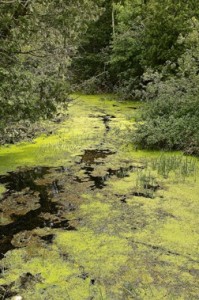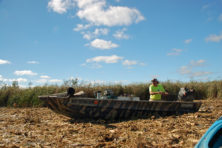Solutions Are Starting at the Dunes Lake Watershed
- Share
- Tweet
- Pin
- Share

The Door County Soil and Water Department, the Sevastopol Town Board, and community members are getting ready to do what they can to save Dunes Lake, which has filled with overgrowth because of an excess inflow of nutrients. Photo by Len Villano.
Deliberations are done, and action is now being taken to save the Dunes Lake watershed, which includes the Sevastopol area lake and about five square miles of the surrounding area.
The Door County Soil and Water Department, along with various other groups, began studying the eutrophication of Dunes Lake in 2008 and presented their findings to the town board and community of Sevastopol last summer. Those findings suggested the lake was experiencing overgrowth and filling in at an advanced rate due to an excess supply of phosphorus and nitrogen in the groundwater feeding the lake.
“We took a canoe trip into the lake to see it firsthand, and it was like a jungle,” said Town Board Supervisor Chuck Tice. “You had to fight your way through. At one point you were just walking and had to pull your canoe behind you.”
Sevastopol then formed a committee to decide if the lake was worth saving and, if it was, how to go about doing it. Tice said the board quickly decided that the lake should be saved, and the efforts will start by trying to manage agricultural sources of phosphorus and nitrogen, i.e. manure runoff.
The Soil and Water Department has already received over $600,000 in grant monies to help farmers voluntarily install or conform to what are known as Best Management Practices (BMPs). These include things like installing manure storage facilities, installing tillage setbacks so the excess nutrients would be filtered out before getting into the groundwater, and rotating crops that require tilling the land out for those that do not.
Tice said the farmers who attended Sevastopol’s most recent discussions of the Dunes Lake situation, held Jan. 29 and 31, understood the problem and want to do what they can to help, but they also need to be able to make a living.
“The majority of farmers understand this,” said Tice. “And they’re very conscientious about what they’re doing right now, but now we need to do a little more because the problem is still there.”
Bill Schuster, head of the Soil and Water Department, said his staff has now begun knocking on doors and studying individual farmers’ current practices, trying to determine which BMPs will be most cost-effective for each farmer to implement.
“The good thing is at all the meetings, whether it be the agricultural community or the non-agricultural community, there’s recognition of the damage being done,” said Schuster. “What drove the debate is what the cost will be to take actions to abate that impact.”
The other major contribution source identified by the study was the wastewater ponds at Sevastopol Sanitary District No. 1.
While the district operates within all of the parameters required by the Wisconsin Department of Natural Resources (DNR), it pumps a significant amount of phosphorus into Geisel Creek when it discharges water from its two detention ponds. In addition, the ponds were built in the ‘70s and testing has indicated some leakage into the groundwater may be occurring.
The sanitary district has already taken some voluntary steps toward reducing its phosphorus discharge and is considering adding a third treatment pond or wetland treatment cell to its system to further reduce the amount of phosphorus in its discharge. The DNR could also place a stricter limit on the phosphorus levels in the system’s discharge, as the district is up for a license renewal this year.
“We also want to get out a mailing to the sanitary district residents to tell them how they can help,” said Schuster. “The more they can reduce the amount of nutrients going down their drain, the less there is to deal with.”
Schuster said residents could help by using items like “green” laundry soaps that don’t contain phosphorous and being conscious of exactly what they’re pouring down their drains.
Ultimately, it’s unlikely that Dunes Lake will ever be completely returned to its natural state, but by working together the community of Sevastopol may at least be able to slow the advanced aging process and make the lake at least resemble a lake again.
“The entire community has to pull together and start paying attention to what they’re using and where they’re using it,” said Tice. “This is just the visible part of the problem. It all boils down to the fact that we’re polluting our water.”

